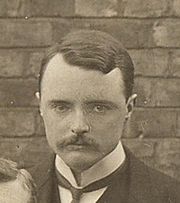Ernest Kennaway facts for kids
Quick facts for kids
Sir Ernest Laurence Kennaway
|
|
|---|---|
 |
|
| Born | 23 May 1881 Exeter, England
|
| Died | 1 January 1958 (aged 76) St. Bartholomews Hospital, London EC1
|
| Alma mater | University College London University of Oxford |
| Known for | Discovery of the first pure compound to show carcinogenic activity |
| Awards | |
| Scientific career | |
| Fields | Pathology |
| Institutions | Guy's Hospital, London; Institute of Cancer Research, London |
Sir Ernest Laurence Kennaway (born May 23, 1881 – died January 1, 1958) was an important British scientist. He studied diseases, especially cancer. He was also a winner of the prestigious Royal Medal.
When he was a child, he spent a lot of time outdoors. This was because he had a childhood illness. Being outside helped him become very interested in nature and science.
Contents
Early Life and Education
Ernest Kennaway went to top universities in England. He studied at University College London. In 1898, he was accepted into New College, Oxford. There, he studied natural sciences.
He earned his first degree in 1903. After that, he spent three years at Middlesex Hospital. He then completed his medical degree. He worked at different research places, including The Lister Institute for Preventive Medicine. Later, he returned to Oxford for more advanced studies. By 1915, he had earned two doctorates in medicine and science.
Discovering Cancer Causes
In 1909, Kennaway started working at Guy's Hospital. He taught about how the body works. By 1914, he became the head of a special department. This department studied the chemistry of diseases.
He began to research how certain substances cause cancer. In 1921, he joined The Institute of Cancer Research in London. There, he made a big discovery. He proved that the cancer-causing substance in coal was a type of chemical. These chemicals are called cyclic hydrocarbons.
Finding Specific Cancer-Causing Chemicals
In 1929, Kennaway made another breakthrough. He found the very first pure chemical that could cause cancer. This chemical was called 1:2:5:6-dibenzanthracene. He also found other chemicals that could cause cancer. One of these was methylcholanthrene.
In 1930, Kennaway worked with another scientist, Izrael Hieger. They showed that certain chemicals, called polycyclic aromatic hydrocarbons (PAHs), could cause tumors. They tested these chemicals on mouse skin. Between 1932 and 1942, he published many articles about these important discoveries. These articles appeared in a famous science journal.
Leadership and Recognition
In 1931, Sir Ernest Kennaway became a professor. He also became the Director of The Institute of Cancer Research. He led this important research center until he retired in 1946.
His amazing work was recognized in 1941. He was given the Royal Medal. This award was for his discoveries about cancer-causing substances in coal tar. It also honored his work on making cancer with man-made chemicals. In 1947, he was honored again. He was made a knight, becoming "Sir" Ernest Kennaway.
Linking Smoking to Lung Cancer
In 1947, a special meeting was held. It was organized by the Medical Research Council. At this meeting, Sir Ernest Kennaway suggested something very important. He thought that smoking cigarettes might be causing the rise in lung cancer. He believed it was more likely than air pollution.
His idea led to a major study. This study was done by scientists named Doll and Hill. Their research later proved a strong link between smoking and lung cancer.
Later Life
Sir Ernest Kennaway suffered from a long illness for over thirty years. He passed away on January 1, 1958. His work greatly helped us understand how cancer starts.

